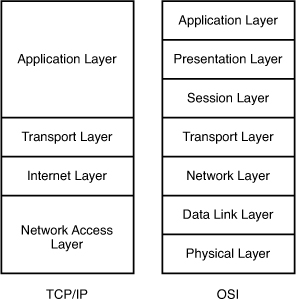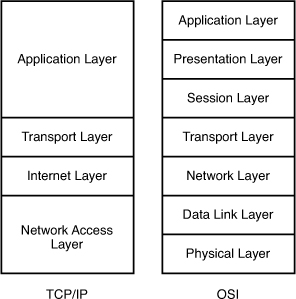- Which statements correctly describe steps in the OSI data encapsulation process?
- A. The transport layer divides a data stream into segments and may add reliability and flow control information.*
- B. The data link layer adds physical source and destination addresses and an FCS to the segment.
- C. Packets are created when the network layer encapsulates a frame with source and destination host addresses and protocol-related control information.
- D. Packets are created when the network layer adds Layer 3 addresses and control information to a segment.*
- E. The presentation layer translates bits into voltages for transmission across the physical link.
Show (Hide) Explanation/ReferenceThe transport layer segments data into smaller pieces for transport. Each segment is assigned a sequence number, so that the receiving device can reassemble the data on arrival.The transport layer also use flow control to maximize the transfer rate while minimizing the requirements to retransmit. For example, in TCP, basic flow control is implemented by acknowledgment by the receiver of the receipt of data; the sender waits for this acknowledgment before sending the next part.
-> A is correct.
The data link layer adds physical source and destination addresses and an Frame Check Sequence (FCS) to the packet (on Layer 3), not segment (on Layer 4) -> B is not correct.
Packets are created when network layer encapsulates a segment (not frame) with source and destination host addresses and protocol-related control information. Notice that the network layer encapsulates messages received from higher layers by placing them into datagrams (also called packets) with a network layer header -> C is not correct.
The Network layer (Layer 3) has two key responsibilities. First, this layer controls the logical addressing of devices. Second, the network layer determines the best path to a particular destination network, and routes the data appropriately.
-> D is correct.
The Physical layer (not presentation layer) translates bits into voltages for transmission across the physical link -> E is not correct.
- What layer of the OSI Model is included in TCP/IP Model‟s INTERNET layer?
- A. Application
- B. Session
- C. Data Link
- D. Presentation
- E. Network*
Show (Hide) Explanation/ReferenceThe Internet Layer in TCP/IP Model is equivalent to the Network Layer of the OSI Model.
- Where does routing occur within the DoD TCP/IP reference model?
- A. application
- B. internet*
- C. network
- D. transport
Show (Hide) Explanation/ReferenceThe picture below shows the comparison between TCP/IP model & OSI model. Notice that the Internet Layer of TCP/IP is equivalent to the Network Layer which is responsible for routing decision.
- Which of the following correctly describe steps in the OSI data encapsulation process? (Choose two)
- A. The transport layer divides a data stream into segments and may add reliability and flow control information.*
- B. The data link layer adds physical source and destination addresses and an FCS to the segment.
- C. Packets are created when the network layer encapsulates a frame with source and destination host addresses and protocol-related control information.
- D. Packets are created when the network layer adds Layer 3 addresses and control information to a segment.*
- E. The presentation layer translates bits into voltages for transmission across the physical link.
Show (Hide) Explanation/ReferenceThe Transport Layer segments data into smaller pieces for transport. Each segment is assigned a sequence number, so that the receiving device can reassemble the data on arrival.The Transport Layer also uses flow control to maximize the transfer rate while minimizing the requirements to retransmit. For example, in TCP, basic flow control is implemented by acknowledgment by the receiver of the receipt of data; the sender waits for this acknowledgment before sending the next part.-> A is correct.
The Data Link Layer adds physical source and destination addresses and an Frame Check Sequence (FCS) to the packet (on Layer 3), not segment (on Layer 4) -> B is not correct.
Packets are created when network layer encapsulates a segment (not frame) with source and destination host addresses and protocol-related control information. Notice that the network layer encapsulates messages received from higher layers by placing them into datagrams (also called packets) with a network layer header -> C is not correct.
The Network Layer (Layer 3) has two key responsibilities. First, this layer controls the logical addressing of devices. Second, the network layer determines the best path to a particular destination network, and routes the data appropriately.
-> D is correct.
The Physical Layer (not Presentation Layer) translates bits into voltages for transmission across the physical link -> E is not correct.
- Which layer in the OSI reference model is responsible for determining the availability of the receiving program and checking to see if enough resources exist for that communication?
- A. transport
- B. network
- C. presentation
- D. session
- E. application*
- Which networking technology is currently recognized as the standard for computer networking?
- A. System network architecture
- B. Transmission control protocol/Internet protocol*
- C. Open system Interconnect
- D. Open network architecture
- Which three encapsulation layers in the OSI model are combined into the TCP/IP application layer? (Choose three)
- A. Session*
- B. Transport
- C. Presentation*
- D. Application*
- E. Data-link
- F. Network
Show (Hide) Explanation/ReferenceThe Internet Layer in TCP/IP Model is equivalent to the Network Layer of the OSI Model.
The first three layers of the OSI Model (Application, presentation and Session Layers) are merged into the Application Layer in the TCP/IP Model.
- On which layer TCP/IP is ACL APIC-EM path?
- A. Layer 1
- B. Layer 2
- C. Layer 3
- D. Layer 4*
CCNA 200-125 Exam: OSI TCP/IP Model Questions With Answers
Subscribe
0 Comments
